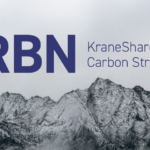
What Is Next for EU Carbon? Key Developments on the Horizon
By Oktay Kurbanov, Partner at Climate Finance Partners (CLIFI)
As the European Union advanced its “Fit for 55” legislation into law, the EU carbon allowance (EUA) market has experienced strong tailwinds, showing an appreciation of 156% since the legislation was first proposed in 2020 to when it became law in 2023.1 As of late, however, EUAs were in the regulatory doldrums as the EU had to deal with its election cycle in 2024, giving back 16% of these gains through the end of the last year.2 The REPowerEU program, which funds the bloc’s energy independence and transition to renewables in response to the Ukraine invasion, provided extra supply of allowances during the 2023-2026 period, putting a damper on the EUA momentum. Absent of new regulatory developments, the market has mostly been trading on natural gas price movements and economic signals as Europe has been recovering from the economic downturn. While the approaching carbon tariff on imports for select high-emitting products into the EU, known as the Carbon Border Adjustment Mechanism (CBAM), is widely viewed as a highly impactful event, many have assumed that the initial impact on the markets will be small until 2026, when it is phased in at the 2.5% level.
This paper will show that sentiment may start to change significantly in 2025 as the market begins to price these developments. Indeed, the EUA futures are up 15% year-to-date already.3 As the economic concerns subside and the European recovery returns to a steady state, the market is expected to be driven once again by policy and supply-demand fundamentals due to the following upcoming developments:
- Finalizing the 2040 Climate Target: By mid-2025, the EU is expected to finalize details for the 2040 climate target plan that calls for a 90% reduction of net emissions versus 1990. A well-functioning carbon market with a steady and sufficiently high price signal is a key policy tool to achieve this goal.
- Financing the Clean Industry Deal: A parallel legislative development is the Clean Industry Deal, which will determine EU’s industry decarbonization trajectory. The European Commission identified the EU ETS as a key financing tool to accomplish its ambitious goal of industry transformation.
- Immediate Impact of CBAM: While news media spoke about a gradual phase-in of CBAM, the analysis of implementation details shows that the immediate impact will be very high for importers of products whose carbon intensity is significantly higher than the EU benchmarks, as is the case with most imports from developing countries. This may induce a significant hedging demand in anticipation of the CBAM compliance phase.
The above factors, combined with the continuing economic recovery of the EU, may converge into a powerful force to propel EUAs back to previously seen €100+ levels that are critical to incentivize energy transition and abatement technologies. With this in mind, we believe there is a strategic window of opportunity for the KraneShares Carbon ETC Programme, which provides exposure to the largest, most liquid carbon allowance futures markets for EU gatekeepers and UK Financial professionals.
2040 Climate Target
In February 2024, the European Commission introduced the 2040 climate target proposal that calls for a 90% reduction of emissions vs. 1990.4 It was intended to bridge the short-term goal of a 55% emissions decrease by 2030 vs. 1990 (“Fit-for-55”) and the long-term goal of net-neutrality by 2050. The proposal was based on the research done by the European Scientific Advisory Board on Climate Change (ESABCC) to create a path for EU decarbonization consistent with the ambition to keep global warming to 1.5C.5
To come up with its recommendations, ESABCC considered 1000 different candidate pathways, with all of them containing common features such as a phase-out of coal power by 2030, phase-out of unabated gas power by 2040, a large scale-up of renewables and transport electrification. This explains why the period through 2040 is so critical: the bulk of the reductions will happen from now through 2040, as one can see in Figure 1 below:

Essentially, setting the 2040 target and ironing out the implementation details is going to make or break the EU’s ambition to achieve climate neutrality in 2050. This is particularly relevant due to ongoing concerns over missing 2030 and 2050 targets, absent of additional policies. In its latest assessment, the European Environment Agency (EEA) indicated that member states will miss the 2030 goal of 55% emissions reduction by 5-10%,6 and the neutrality goal in 2050 is at an even larger risk of being missed, as one can see in Figure 2:

The 2040 proposal establishes an annual investment target of €1.5tn a year split between energy systems and transport, representing 7.5% of GDP. This will allow the EU to target ambitious emissions reduction goals across various sectors, as shown in the table below:

Carbon pricing will play a crucial role to facilitate and incentivize achieving these goals. In its communication document, the European Commission (EC) noted that “the EU ETS {Emissions Trading System], with its common carbon price, provides a market-based tool to innovate with long-term predictability for Europe’s main emitters. For some industries, this implies investing in a profound transformation of the production process.” The EC noted that together with targeted investment support, “carbon pricing will remain a principal driver for change.” These changes will encompass electrification and switching to alternative fuels, innovation in low-carbon processes, and circular business models.7
The above-mentioned market-driven incentives for process transformation can only happen with sufficiently high levels of carbon prices. Strong policy support makes it much more likely that the EUA prices will rise to €100 and above to incentivize abatement and establish a new production process to achieve the 2040 climate target.
Clean Industry Deal
Over the last few years, the European Union has struggled to lay out a credible path to a net-zero economy while maintaining industrial competitiveness, avoiding leakage to economies with more relaxed carbon pricing, and preventing industrial demand destruction due to high energy prices. The European Green Deal, adopted in 2019, has been at the center of EU’s policy-making for five years, accomplishing “Fit for 55” and enshrining net-neutrality by 2050 into the law. However, the policies drew criticism from the industrial entities that have been subject to severe economic and geopolitical pressures. The day after the release of the 2040 climate target proposal, the Alliance for Energy Intensive Industries pleaded that the “EU climate policy must … go together with ambitious industrial policy that facilitates a viable and solid business case for the climate transition… This is a make-it or break-it moment for the EU to revert the deindustrialization risks.”8
Against this background, the re-elected EC President Ursula von der Leyen committed to putting forward a new Clean Industrial Deal that will channel investment in infrastructure and industry, especially energy-intensive sectors. The ultimate goal of the deal is “to reconcile climate protection with a prosperous economy.”9 EC climate commissioner Wopke Hoekstra outlined several elements of the Clean Industrial Deal in his December 2024 speech at the EnerGreenDeal conference. Reducing high energy costs is a high priority due to its destructive effects on the industry over recent years. To address this issue, there needs to be an increase in affordable clean power, power purchase agreements, and investments in grid and infrastructure. Hard-to-abate industries will require public support mechanisms to stimulate investment and demand for green products. This will be complemented by industrial carbon management through the development of CO2 transport and storage infrastructure.
With the above said, the very first element of the deal brought up by Commissioner Hoekstra was the financing side and the key role of the carbon markets: “the EU ETS puts a price on pollution. It also generates billions in revenue each year to finance clean industrial investments.”10 In his previous comments, the commissioner called the EU ETS “truly the crown jewel and the workhorse,” enabling the EU to achieve its climate goals.11 Over the last couple of years, the ETS generated around €40 billion in annual revenue for member states, becoming an integral part of financial planning. Thus, European carbon allowances’ price stability and steady appreciation ensure both the financial viability of the Clean Industrial Deal as well as provide economic incentives for hard-to-abate sectors to decarbonize.
One of the primary motivations and goals of the Clean Industrial Deal is preventing industry leakage due to the EU’s carbon policies. The introduction of the CBAM is a key policy tool to accomplish that while providing additional financing to further drive decarbonization. While CBAM is expected to level the playing field for the European-based companies, it will present new challenges for the importers into the European Union, as discussed in the next section.
CBAM: Step-Function Impact on Importers
Figure 3 below presents a familiar diagram illustrating a “gradual” phase-in of CBAM, which is synchronized with a gradual phase-out of free allocations of allowances to the EU industry:

This figure does not show how exactly the CBAM phase-in % is used in computing the carbon liability of importer companies. Figure 4 below illustrates how CBAM phase-in percentage factors in. Note that the credit for local carbon prices paid in exporting countries is ignored for simplicity, assuming it stays constant pre- and post-CBAM and does not affect incremental impact:

One notices that for the purposes of CBAM liability, the product’s carbon intensity is reduced by the “carbon intensity threshold,” based on the EU benchmark carbon intensity – helping the importers by reducing their liability. As the CBAM phase-in % increases over time, the EU benchmark gets scaled down more and more, decreasing this threshold, which in turn increases the CBAM liability. However, the obligation for EU importers will be material even if the CBAM phase-in is at 0% and the carbon intensity threshold is at its max value. This is because the EU benchmark carbon intensity is determined based on the top 10% lowest emitting EU installation for a given sector, while the carbon intensity of products imported into the European Union – mostly from developing countries - is typically much higher. This is why the importers would be hit with a step-function increase in 2026 when, all of a sudden, they are taxed based on the difference between their carbon intensity and a very low carbon intensity target, making the impact immediate and relatively high.
As an example, consider a hypothetical EU company that imports Chinese steel. Since a large portion of China’s steel production relies on coal-fired electricity, its carbon intensity is very high, around 2.1t of CO2 per ton of steel produced.12 On the other side, EU steel companies are using renewable electricity and more efficient facilities, resulting in the carbon intensity benchmark of 1.249t of CO2 per ton of steel.13 Table 2 shows the impact on the EU importer due to CBAM introduction in 2026 in terms of additional costs per ton of steel imported and as % of the revenue under three 2026 EUA price scenarios:

One can see that despite a small 2.5% phase-in of CBAM in 2026, this importer will be hit with an immediate 12% CBAM charge on its revenue, based on the current level of EUA prices. This situation of an immediate high impact is similar across other CBAM sectors such as aluminum and cement as well as other exporting countries such as Brazil, India, and Turkey since local production there is more carbon-intensive due to fossil-based electricity and less advanced technologies.
The importers face an even greater loss if EUA prices increase significantly from the current levels as in the base case (“med” column) or in the bullish case (“high” column). These scenarios can simply drive companies out of business. This is why, as 2026 is approaching, the first year of CBAM compliance, many importers may want to eliminate the price risk and lock into their profits. This dynamic will play itself over the course of 2025 and should provide tailwinds for the EUA prices due to additional hedging demand.
Conclusion
After two years of relatively easier supply and uneventful policymaking, there is hope that 2025 will bring some upside excitement in the EUA market. By mid-2025, the regulators are expected to deliver the details of the 2040 Climate target and the Green Industry Deal proposals. The EU ETS plays a crucial role in achieving both of these objectives in terms of funding and ensuring compliance meets the emissions reduction target. The latter can only be accomplished with a sufficiently tight supply/demand balance and strong price signal. On the net, these regulations are expected to support the carbon market.
By now, the market should have priced-in extra supply due to REPowerEU, while the upcoming shortages caused by bringing this supply forward from years 2027-2030 should soon start to affect hedge-management decisions by compliance entities. An exciting development in 2025 will be the approaching CBAM compliance phase starting in 2026 and all the planning, logistical, and hedging activity leading to it. Economic risks will still remain and may impede the pace of recovery of EUA prices. European Union’s economy is recovering but at a more modest growth rate in the range of 1.5-1.7% in the next 5 years.14 Looking ahead, the regulatory developments should support EU carbon in 2025 and beyond.
For KRBN standard performance, top 10 holdings, risks, and other security information, please click here.
Citations
- Source: ICE, EUA front Dec futures return. From 9/15/2020 (State of the Union address by President von der Leyen) to 8/Oct/2023 (EC communication)
- Source: ICE, EUA front Dec futures return as of 31/Dec/2024.
- Data from Bloomberg as of 31/Jan/2025.
- European Commission, “Europe's 2040 climate target and path to climate neutrality by 2050 …”, 6/Feb/2024
- ESABCC, “Scientific advice for the determination of an EU-wide 2040 climate target …”, 14/Jun/2023
- EEA, Total net greenhouse gas emission trends and projections in Europe, 10/31/2024
- European Commission, “Europe's 2040 climate target and path to climate neutrality by 2050 …”, 6/Feb/2024
- EUROFER, 2040 climate target: joint statement by the Alliance of Energy-Intensive Industries, 7/Feb/2024
- European Commission, Statement at the European Parliament Plenary by President Ursula von der Leyen, 18/Jul/2024
- Speech by Commissioner Wopke Hoekstra at the 4th European EnerGreenDeal Conference, 12/Dec/2024
- Bruegel, Conversation with Commissioner for Climate Action, Wopke Hoekstra, on 2040 EU climate target, 13/Feb/2024
- Source: Global Energy Monitor Briefing, March 2024
- European Commission, Update of benchmark values for the years 2021 – 2025 of phase 4 of the EU ETS, 10/Dec/2021. Using previous period’s 3% benchmark decrease rate to forecast 2026-2030 benchmark value.
- Source: IMF, World Economic Outlook, October 2024















